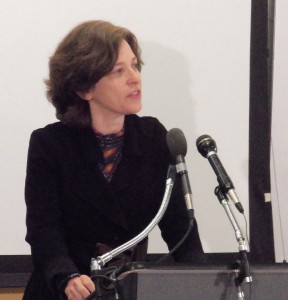WASHINGTON – The actions taken by the Federal Open Market Committee are completely appropriate, said Federal Reserve Governor Sarah Bloom Raskin Monday morning.
Raskin was defending the decision last week to sell $400 billion in short-term Treasury securities and buy back the same amount in long-term bonds. The exchange, known as “Operation Twist,” will take place by the end of June 2012.

Federal Reserve Governor Sarah Bloom Raskin addressed monetary policy, job creation and the new tools being used to stimulate the nation's recovery at a speech on Monday. (Photo by Anjelica Tan/MNS)
“She made a persuasive case that the Fed has acted very strongly both in conventional policy by bringing interest rates down and in unconventional policy by buying back securities,” said economist Alice Rivlin of the Brookings Institution, a nonprofit public policy think tank. Rivlin formerly served as vice chair of the Federal Reserve in the late 1990s under President Bill Clinton.
The FOMC implemented the original “Operation Twist” in 1961. This is the first time since then that it’s been put back in action. The model is intended to lower long-term interest rates as a way to stimulate investment. Not everyone agrees that the Federal Reserve made a sound decision by pushing “Twist” a second time around.
“Financial markets will be going around trying to figure out what the Fed’s up to now,” said Douglas Holtz-Eakin, former chief economist for the Council of Economic Advisors under George W. Bush and president of the American Action Forum, a nonpartisan, center-right policy institute. “That’s a distraction to real growth.”
In her speech, hosted by the Center for Financial Policy in Washington, Raskin emphasized the Fed’s efforts since 2008 to provide investors with forward-looking guidance about interest rates to minimize confusion in the markets in these “extraordinary economic and financial conditions.”
She also addressed the “hawk” and “dove” labels used to characterize the various FOMC members in how they individually prioritize the Fed’s two goals of price stability and maximum employment. “Hawks” prefer higher interest rates to maintain low inflation, while “doves” favor low interest rates to encourage investment and growth.
“We are neither hawks nor doves but owls,” Raskin said. “We are trying to be as wise as possible in deploying all the tools we have to fulfill our legal mandate.”
Diane Swonk, chief economist at Mesirow Financial in Chicago, believes that statement is true. “The debate within the Fed is far more complex than those labels suggest,” she said in an email Monday.
Swonk’s colleague, Adolfo Laurenti, explained both sides of the debate outside of the Fed’s walls. “On one side, I understand the Fed is trying. It’s a really rough spot for them. On the other side, I understand why the market is so skeptical because this is something that isn’t proven yet,” said Laurenti, who is Mesirow Financial’s deputy chief economist.
The Fed has already taken all the traditional policy actions, Laurenti explained. “They’re experimenting with these unconventional policy tools, like the expansion of the balance sheet and ‘Operation Twist,’ which has been done only once before.”
Laurenti put it simply: “If you don’t have anything else to do, you try what you can.”
